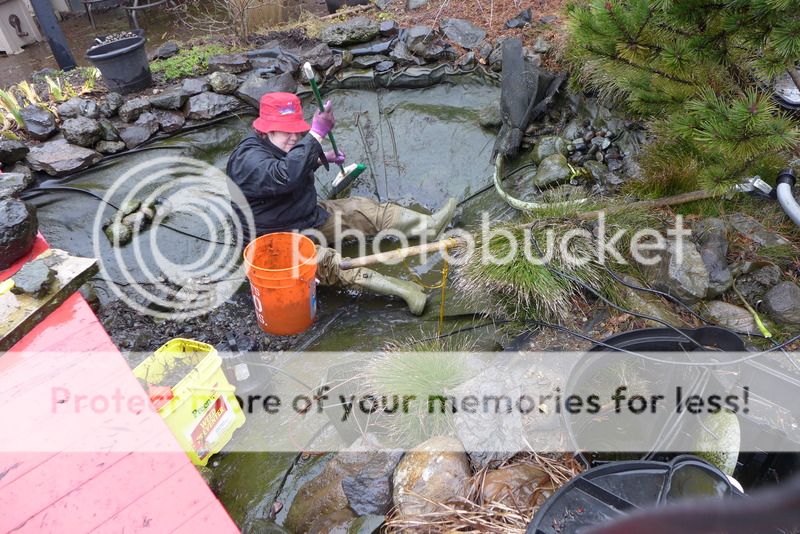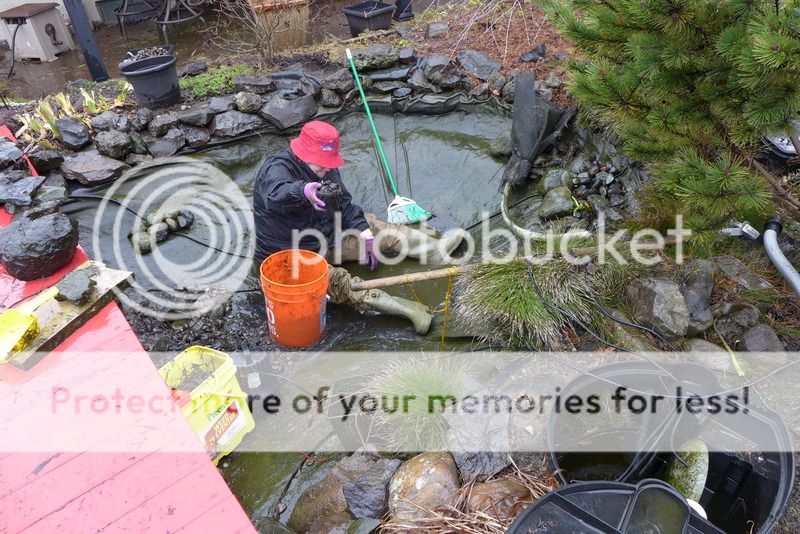…of ten years of rocks sliding in; and just dust; and evergreen needles. And stuff. The very bottom of the wintering-over pit is, well, due for a cleanout. And a lot of rocks have rolled down there over the years.This is the pond drained down. We’ve thrown towels over the particularly exposed water lilies to keep them wet.
And here is Jane, in waders and thermals, at 48 degrees, in the rain, cleaning out the wintering-over pit. She’s restacked the rocks on the rim, a hands-and-knees job, and the water in that pit is green.
She toasts us with a cup of what she’s scooping out—old needles, sand, pebbles—

Thanks for the pix! Here’s hoping the pond becomes both beautiful and sustainable in short order.
My tiny water garden is about the size of your “wintering over” pit. Because it’s small and “get-at-able,” I drain and scoop it of leaves, pebbles, eroded dirt… and dead worms each spring. The water and muck make great a compost stew to throw on the garden and around trees and bushes. And then I start fresh all over again.
New resolution: every couple of years, we drain it down, put the fishies into the lotus pond and do EXACTLY that. Cost effective compared to a million partial water changes and so much better than Carolyn having to spend the entire summer cleaning filters. (Corollary: this way, she’ll have time to help me with the weeding! :D) I’ve actually wanted to do it for a looooong time, we just never got around to it.
Huzzah! Good to see you, Jane! Will you be reactivating your page, or letting it lie fallow for a while (considering the hassles CJ has been having getting WWaS running properly again).
We are getting all the pages up and going one after the other. ‘Chuck’ is helping us modernize and making us up with smartphones and such, and we are looking forward to functionality.
Ooh, I am exceedingly glad I am not Jane today! LOL! Best Wishes Both.
Part of my furniture got moved in today. Hurray, I now have the computer and printer on my dresser, and am sitting on my office chair. Much better with the bedroom furniture and with a makeshift desk and workable chair.
More to arrive this week and next; most things are haphazardly in storage and will have to be gotten out piece by piece. Already much better.
The cats gave everything a thorough smell and looking over, and declared themselves happy to see their old stuff back. (“Ooh, we can sit here and look out the window. Good work, human!”)
My camera is in amongst the guest bedroom stuff, as are the BJD crew, or I’d have a photo or two. So, photos of the new digs later!
Still thinking about the chemistry and physics of the thing. To protect from suffocation when it ices over, it’d be pretty simple to add a (small, because their metabolism isn’t so fast?) air pump & hose to the bottom of the over-wintering pit to provide local oxygenation. Water may freeze around the hose, but shouldn’t prevent the air passage. A Y-splitter to a hidden, stoppered hose you can get to should tell you if there’s still airflow. But rotting vegitation would produce hydrogen sulfide–which is actually more poisonous than hydrogen cyanide–that messes up the pH. That could be neutralized by rocks of limestone (calcium carbonate) in the pit. The bubble of the air pump would provide some mixing, and actually absorb some of the hydrogen sulfide and carry it off. I’m thinking limestone isn’t particularly soluble in neutral water so it shouldn’t make the water too alkaline for the koi.
You’ve got one fix, but I’ve always avoided “single points of failure” when I can anticipate them and handle with them in a cost-effective manner, i.e. this isn’t the only working computer I have–there an identical twin right beside and a couple more brutish cousins just across the room!
I’m sure people in the midwest and northeast have this figured out, of course.
Hey! Where’d it go? Something seems to be swallowing comments again. 🙁
Made of sterner stuff than I, is your Jane. Worth more than rubies.
Re: The small stream at the back corner of the yard, is it still running well? I remember there was a slight problem with losing water, and Jane (and I) humped that little bridge over from the garage to place it over the stream. I hope it’s still running.
I also hope you’ll be able to use the globe again.
That’s the lotus pond, which is in good shape.
And yes, the bubble is safe and sound: we store it in the basement for winter. Use may be limited for a few years because of the need to net the pond while we have little fishes in there (big fishes are expensive)…but it is treasured and safe.
OK, I’m gonna try one more time. (Yay, it’s working!) I’m still puzzling out a foolproof way to protect the koi. It’s just a solvable physics, chemistry, engineering problem! Even though you have one fix, I don’t like “single points of failure” if they can be handled cost-effectively.
A small (because their metabolism is slowed by cold water) air pump with the tube to the bottom of the pit, should be able to provide oxygenation. A Y-splitter with a plugged tube (it will be low pressure air) hidden somewhere you can access it, can give you a way to confirm air is still being pumped.
The problem, when it ices over, though is rotting vegitation producing hydrogen sulfide that can’t escape, messing up the pH. (The bubbles will absorb some of the H2S and carry it up.) But I think you can mitigate that with a limestone rock (calcium carbonate) or two in the bottom of the pit. Holding the oxygen tube down? In neutral water the limestone shouldn’t make the water too alkaline for the koi. When the rotting vegitation produces H2S, the CaCO3 will buffer it.
Not saying the issue could be neglected after such an installation, but it should provide an extra measure of protection!
Paul, we’ve found something very similar to your idea: it’s a winter aerator. http://www.drsfostersmith.com/product/prod_display.cfm?pcatid=18057
A pump hangs below, draws water from a foot and a half down and cycles it to the surface under that little dome, so it can release any CO2. It has a small heater assuring that the water does not freeze in the column, and allegedly works into the minus teens, which is all we ever get.
It also is quiet enough that it doesn’t mix the warmer water at the bottom of the pond with the near-freezing at the surface. It returns the degassed water to the pond. We also do provide buffer, so you are quite right in that.
Sounds good. I know finding a basalt rock in Spokane is a piece of cake, but limestone might be tougher, but still should be doable. I’ll bet Joe can find a couple rocks! I think it would provide that extra bit of buffering.
I actually have one. It’s rescued from the pile and sitting on the bridge awaiting replacement.
We live in south central Wisconsin, where our soil is karst — a shallow layer of topsoil over limestone (we live near the Cave of the Mounds). Digging a garden yields an *ample* harvest of limestone rocks. If you would like some genuine Wisconsin limestone, I’d be delighted to send some to you! [Of course, it would come with lots of local biota attached, even if I scrub it well, so that might be a hindrance.]
Limestone – I’d try a marble and granite place, where they’d likely also have limestone in tiles or slabs, and scraps should be available.
wow, have to salute Jane, that is a very tough job. especially at that temperature.